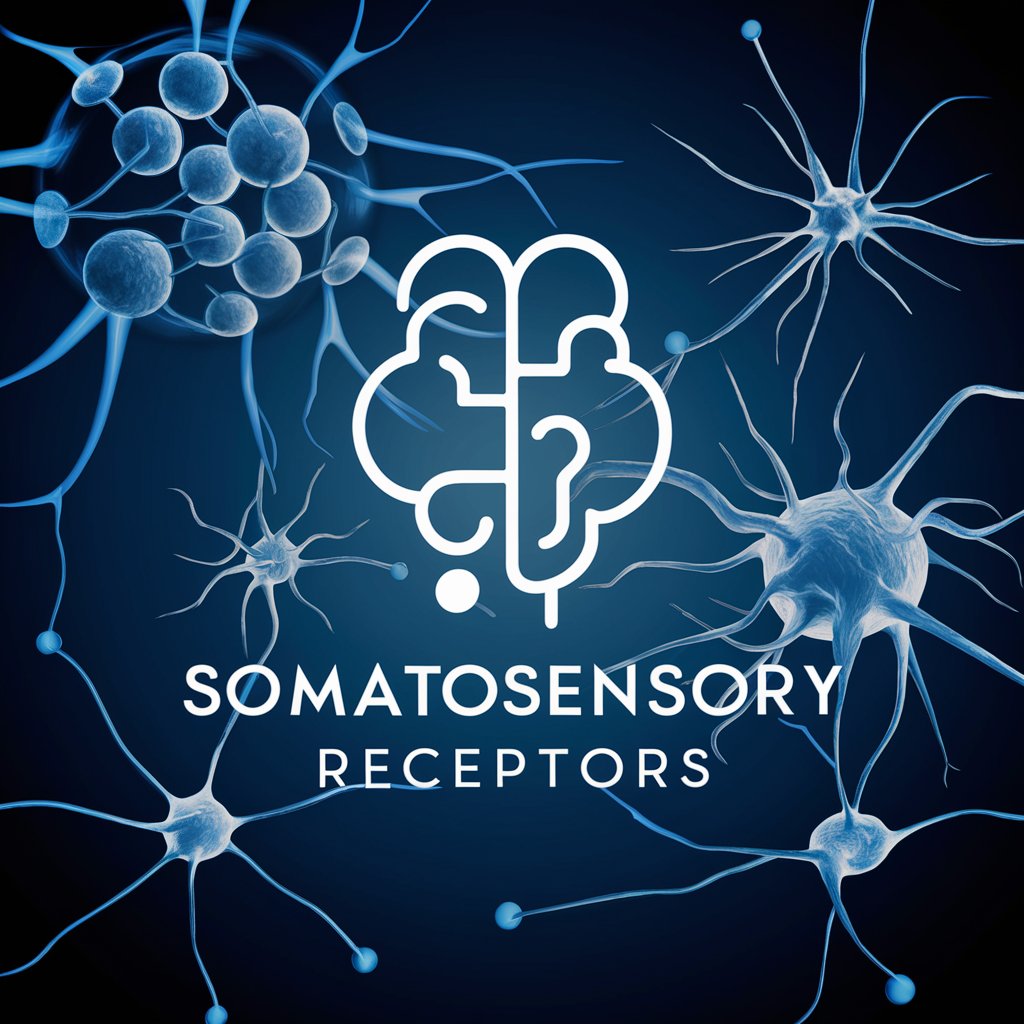Somatosensory Receptors - sensory receptors tool

Welcome to Somatosensory Receptors, your academic guide to the sensory world.
Decoding touch and motion with AI
Describe the specific types of stimuli that each class of somatosensory receptors detects.
Explain how sensory transduction converts physical stimuli into electrical signals in sensory receptors.
Compare the different sensory receptors based on their adaptation rates and receptive field sizes.
Discuss the role of proprioceptors in maintaining body position and facilitating movement control.
Get Embed Code
Introduction to Somatosensory Receptors
Somatosensory receptors are specialized structures designed to detect and respond to various physical stimuli from both external and internal environments. These receptors are fundamental components of the somatosensory system, which encompasses senses such as touch, pain, temperature, and proprioception. Each receptor type is specifically tuned to certain kinds of stimuli, such as mechanoreceptors for touch, nociceptors for pain, thermoreceptors for temperature, and proprioceptors for body position and movement. An example of their function is seen in the process of reading Braille, where mechanoreceptors in the fingertips detect the raised dots and convey this tactile information to the brain, enabling the perception of letters and words. Powered by ChatGPT-4o。

Main Functions of Somatosensory Receptors
Sensory Transduction
Example
Converting physical stimuli into electrical signals
Scenario
When touching a hot surface, thermoreceptors detect the increase in temperature, leading to the generation of nerve impulses that inform the brain of potential harm.
Modulation of Sensory Input
Example
Adjusting the body's response to sensory stimuli
Scenario
Golgi tendon organs modulate muscle tension by causing muscle relaxation when excessive tension is detected, preventing injury.
Integration of Sensory Data
Example
Combining different sensory inputs for coordinated response
Scenario
Proprioceptors in joints and muscles work together to provide comprehensive feedback on body position, essential for complex movements like playing a piano or engaging in sports.
Ideal Users of Somatosensory Receptor Services
Students and Educators
Students studying neuroscience, biology, or related fields can gain an in-depth understanding of human sensory systems. Educators can use this detailed information to enhance their teaching materials and laboratory exercises.
Healthcare Professionals
Physicians, physical therapists, and other healthcare providers benefit from understanding how different receptors contribute to sensory disorders. This knowledge helps in diagnosing conditions, planning treatments, and educating patients about their sensory symptoms.
Researchers
Researchers in neurosciences use detailed receptor functions and mechanisms to explore new areas like sensory augmentation devices, pain management therapies, and advanced prosthetics that mimic natural sensory feedback.

Using Somatosensory Receptors
Step 1
Visit yeschat.ai for a free trial, no login required, and no need for ChatGPT Plus.
Step 2
Familiarize yourself with basic neurophysiology concepts, particularly those related to sensory systems, to effectively utilize this tool.
Step 3
Use specific queries related to the somatosensory system, such as the types of receptors or stimulus encoding, for precise answers.
Step 4
Integrate the insights provided into academic or research projects, ensuring to cite relevant neuroscientific principles and findings.
Step 5
Regularly explore various features and updates of the tool to enhance your understanding of somatosensory receptors.
Try other advanced and practical GPTs
Metaphysician
Navigate Life’s Questions with AI

Famous Artists Style Guide Wizard
AI-powered artistic inspiration at your fingertips.

Dali XT for Advanced Artists
Elevate Art with AI Precision

Artist's Assistant
Empowering Your Artistic Journey with AI

Artist's Diary Assistant
Streamline your art, powered by AI

Artiste Moderne
Revolutionize creativity with AI-powered artistry.

Escucha
Mirror your thoughts with AI-powered reflections.

ㅤㅤㅤㅤㅤㅤㅤㅤㅤㅤㅤㅤㅤㅤㅤㅤㅤㅤㅤㅤㅤㅤㅤㅤㅤㅤㅤThe Binary Contemporium
Transforming Ideas into Binary Brilliance

Asistente de Redes FI UNAM
Empowering Network Education with AI

React Toaster
Empowering interactions with AI-driven notifications

RM
Craft Your Professional Persona

Ingeniería Geomática UNAM
Mapping the future with AI-driven geomatics education

Q&A about Somatosensory Receptors
What types of stimuli do somatosensory receptors respond to?
Somatosensory receptors respond to a variety of stimuli such as touch, pain, temperature, and proprioceptive information concerning body position and movement.
How does sensory transduction occur in these receptors?
Sensory transduction in these receptors involves converting the energy from a physical stimulus into an electrical signal, usually through mechanisms like receptor potential and action potentials.
What are rapidly adapting receptors?
Rapidly adapting receptors are types of sensory receptors that respond quickly to a stimulus but cease firing if the stimulus continues, making them effective in detecting changes rather than steady states.
Can you explain the role of muscle spindles in proprioception?
Muscle spindles play a crucial role in proprioception by detecting changes in muscle length, thereby contributing to the sense of body position and movement through reflex arcs and feedback mechanisms.
What is the significance of Golgi tendon organs?
Golgi tendon organs help monitor and regulate muscle tension, protecting muscles from damage due to excessive load by triggering reflexive muscle relaxation.
